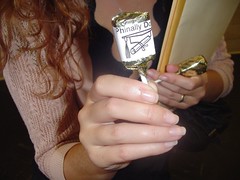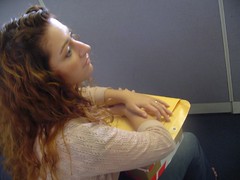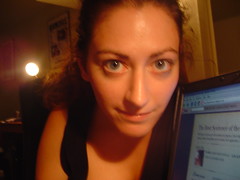Sunday, July 30, 2006
See Jane Done. Done, Jane, Done!
This Might Be a Dissertation
In this photo, I am waiting in the lobby of the graduate division office to file my dissertation, which weighs in at 588 pages and is three and a half inches high, printed on archival paper for the library.
I wanted to post some information here about my dissertation on this blog. Since it will be months before ProQuest has it in its online dissertation library, you should email me (contact info in my blog profile) if you'd like to read any of it.
This Might Be a Game: Ubiquitous Play and Performance at the Turn of the Twenty-First Century
ABSTRACT
This Might Be a Game examines the historical intersection of ubiquitous computing and experimental game design, circa 2001 AD. Ubiquitous computing, or ubicomp, is the emerging field of computer science that seeks to augment everyday objects and physical environments with invisible and networked computing functionality. Experimental game design is the field of interactive arts that seeks to discover new platforms and contexts for digital play. The convergence of these two fields has produced a significant body of games that challenge and expand our notions of where, when, and with whom we can play. This dissertation explores how and to what ends these playful projects reconfigure the technical, formal and social limits of games in relation to everyday life.
To mark the heterogeneity of this experimental design space at the turn of the twenty-first century, I propose three distinct categories of ubiquitous play and performance. They are: ubicomp games, research prototypes that advance the scientific agenda of ubiquitous computing through game design; pervasive games, performance-based interventions that use game imagery to disrupt the normative conventions of public spaces and private technologies; and ubiquitous games, commercial entertainment projects that replicate the interactive affordances of video and computer games in the real world.
I examine seminal games from each of these three categories, including Can You See Me Now? (Blast Theory/Mixed Reality Lab, 2001); the Big Urban Game (The Design Institute, 2003); and The Beast (Microsoft, 2001) respectively. My discussion draws on original gameplay media, design statements, and first-person player accounts. My critical framework is based on close readings of the play and performance values expressed in the founding ubicomp manifestos of Rich Gold and Mark Weiser. I argue that the persistent responsiveness developed by players to potential ludic interaction represents a new kind of critical gaming literacy. The gamers grow to read the real world as rich with ludic opportunity, carefully testing everyday media, objects, sites, and social situations for the positive and negative consequences of inscribing each within the magic circle of play. I conclude by outlining a course for the future study of these categories that is based in the pre-digital games theory of Johann Huizinga, Roger Caillois, and Brian Sutton-Smith. I argue that as the perceived opportunities for digitally networked play become increasingly ubiquitous, game designers and researchers must attend more carefully to the insights of philosophers, anthropologists and psychologists who historically have explored play as an embodied, social and highly consequential ritual, always already grounded in the practices of everyday life.
Dedication and Acknowledgments
I dedicate this dissertation to the ubiquitous gamers.
Through their collective and playful performances, they have embodied and embraced a more intimate relationship between gameplay and everyday life.
This dissertation would not have been possible without the exceptionally valuable guidance and support I have received from my co-chairs, Professor William B. Worthen and Professor Gregory Niemeyer. They have broadened and deepened my understanding of performance and play immeasurably, while helping me develop the critical perspective necessary to balance my games research with my game design practice. This dissertation also has benefited enormously from the critical review of committee members Professor Ken Goldberg and Professor Peter Glazer, who have informed greatly my understanding of where art practice meets research, while helping me to clarify the technological, social and political stakes of this project.
I want to thank the innovative game designers and developers who invited me to be a part of the playful experiments that inspired this dissertation. In the fall of 2001, Ian Fraser and Finnegan Kelly at The Go Game (Wink Back, Inc.) gave me my first opportunity to participate in experimental game design. Since the summer of 2004, my colleagues at 42 Entertainment have given me a home to continue exploring and inventing new platforms and contexts for gameplay. I especially am grateful to Elan Lee and Sean Stewart, who supported this research project even before there was a 42 Entertainment.
Some ongoing design and research dialogues over the past few years have also been quite important to this dissertation’s development. I especially want to acknowledge Ken Anderson, Eric Paulos, and Joseph McCarthy, all of whom I first had the pleasure of meeting through Intel Research workshops and colloquia. My conversations with each have expanded, tremendously, my understanding of the relationship between technological innovation and play.
Looking back over the course of this dissertation’s development, two particular moments stand out as having led, quite unexpectedly but fortuitously, to its final shape and subject matter. In the spring of 2002, Professor Mark Sandberg organized the most enriching seminar I have had the pleasure of participating in, and guided me in developing my first digital games paper: a study of The Beast (Microsoft, 2001) as interactive back story. Through Professor Sandberg’s support and interest in that seminar paper, I came to realize that I had something important to say about games. Without his early attention to this project, this dissertation would not exist. And in the fall of 2003, Professor Gregory Niemeyer invited me to collaborate on a playful installation at the Fifth International Conference on Ubiquitous Computing. Without this opportunity and my subsequent exposure to the field of ubicomp research, I never could have conceived of this project in its current form. I am most grateful to Professor Niemeyer for trusting me as an artistic collaborator, and for being the first person to introduce me to a field of research that has changed the way I think about how and why we interact with computer systems.
I thank everyone who read, supported, and commented on my “Best Sentence of the Day” dissertation blog. Having a live audience for the writing process was a great motivation for me. I especially thank fellow games researcher and game designer Ian Bogost, whose daily support and critical feedback online gave me the momentum to keep writing.
Finally, a few important personal acknowledgements: I want to thank my twin sister, Kelly McGonigal, who was born six minutes before me, but who finished her Ph.D. two years before I did. Her success was an inspiration to this dissertation, and her insights were essential to its completion.
I thank my parents, Judith and Kevin McGonigal, for their love and support, and for sharing their intellectual curiosity with me.
I thank my husband Kiyash Monsef, because of whom I think more clearly, play more often and live more fully.
Saturday, July 01, 2006
The Dissertation Draft is Done
The disseration draft is done.
What that means:
It's over 500 pages. I know. Ridiculous.
Over half of it has already been approved by my two co-chairs.
My other two committee members have just started reading it, plus I have the final chapters and conclusions to be read by all.
There will be about a month now of feedback and revisions. I will file, if everything goes according to plan, the first week of August.
P.S. The look on my face in the photo -- me by my laptop open to my best sentence of the day blog, where I have just posted my last best sentence of the day... that is the face of a woman who just finished writing and emailing off the final chapters five minutes ago. i think it is a look of blank stunned exhaustion. I have worked 7 days a week since late January, my writing hours went from 12 a day up to 7 AM to 1 AM over the last few weeks, and if you want to know what I am doing tomorrow, I will tell you:
--drinking champagne, possibly all four bottles that we currently have in our refrigerator, WHILE
--cleaning the apartment!!! WOO!! you have no idea how much I have been wanting to do both these things. now i shall do them at the same time. possibly while playing the battlestar gallactica soundtrack and the hannah montana themesong.



